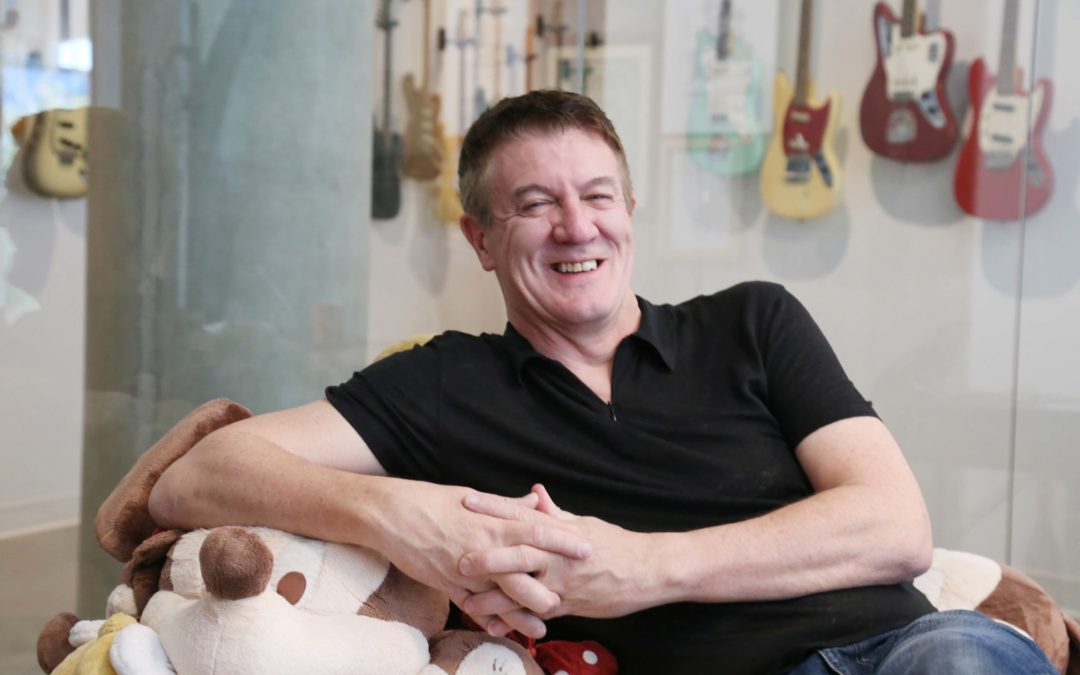GAMA Q&A
Andy Mooney, CEO, Fender Musical Instruments Corp.
By Dan Ferrisi

Fender CEO, Andy Mooney
Photo Credit – Henry Diltz
Few musical instrument companies have the universal brand recognition that Fender Musical Instruments Corp. (FMIC) has achieved, and a big part of the reason why is that the company has been responsive to not only instrument trends, but also societal trends. Recently, GAMA caught up with Andy Mooney, CEO of FMIC, to discuss the company’s progress since he was recruited in 2015, the bright future he envisages for electric guitars, FMIC’s investment in the Fender Play online learning program and digital platform overall, and how FMIC dealers have begun to change perspectives on the company’s decision to pursue some direct-to-consumer sales. Most importantly, Mooney shares key insights on how to create more guitar players, thereby seeding the next generation.
You’ve been at the helm of FMIC for well over three years now. What’s been your progress toward achieving the goals you set upon being recruited?
The expectations of Fender’s board on the core side were fairly modest, because the assumption at that time was that the industry was flat and that Fender had particularly high market share in electric guitars and amps. But, there was a big opportunity for growth on the digital side. It just wasn’t clear what the strategy and tactics should be. What actually happened is we’ve seen very strong growth in the industry overall. And, in addition to that, we’ve grown our market share. Now that we are on the path to getting Fender digital successfully up off the ground, we’re very happy with progress to date. Success in Digital products and services, particularly with Fender Play, is symbiotic to our core business and accelerating growth in the core business. On the core side, we’ve grown our top line high single digits going into our fourth year now. We continue to grow market share, and we have 70,000 users in Fender Play in our first year of operations.
You see the Fender brand not only emblazoned on headstocks, but also on everything from T-shirts to bookends. What’s the cachet of the Fender brand 72 years after its founding?
Brand equity is established for the long run with great brands like Fender, Nike or Disney as the cumulative effect of making great products. Fender has been making great products for 70-plus years, and really focused on product quality. The fact that 80 to 90 percent of artists who are playing electric guitar and amps on stage at the major festivals are playing Fender-branded instruments is a testament to this. That’s really what’s defining our cachet—the adoption by artists of the product in the long run.
Back in June 2017, the Washington Post published its much-discussed “death of the electric guitar” story. Now, about 18 months later, how prescient or wrongheaded does that article seem?
Well, it was wrong then, and it’s even more wrong now. The reality is, all of the data—from multiple sources—confirms that the industry has been growing healthily for the last four years. And there are two drivers that are actually accelerating growth: One is demand for recorded music. You know, 178 million people are now paying for a monthly music streaming service, and a lot of the growth there is coming from back catalog music, which is dominated by electric guitar. And there’s festival music, where, again, the dominant instrument is electric guitar. Live Nation, a public company, had 2017 results indicating 86 million people went to a Live Nation concert—up 21 percent over the prior year.
Internally, we’ve been doing what we can as a leader to try to drive industry growth, and I think we’ve succeeded. We’ve doubled our marketing investment over the last three years and shifted the marketing emphasis to consumer direct. That’s particularly true over social media, where we now have seven-million-plus followers across our channels. We’ve stepped up the pace of product innovation. And we’ve invested in Fender Play, which is bringing more new players into the market than ever before and reducing the abandonment rate of those players so more of them, as a percentage, become committed lifetime players.
Tell me what we’ve learned from the “Illuminating the State of Today’s Guitar Players” research that Fender recently released. What were the most important or most surprising takeaways?
The research that we recently published was an update and expansion of research we did three years ago in the US, which underpinned the strategies we’ve been executing for the last three years. From that initial research, it was a surprise to the team that 50 percent of new guitar buyers were women. That statistic has remained consistent in the latest update, and it has proven to be global. Second, we learned that 45 percent of all of the guitars that we sell every year go to first-time players. That was a much higher percentage than we anticipated. But we learned 90 percent of those first-time players abandon the instrument in the first year, if not the first 90 days. So, our industry and our brand don’t have a problem attracting new entrants—we have a retention problem. The 10 percent of the salmon, as it were, that make it through the dam tend to commit to the instrument for life and have a lifetime value of $10,000 or more. They might buy five to seven guitars, multiple amps and multiple accessories. So, our focus has widened from concentrating not only on already-committed players but also supporting first-time players—getting more first-time players in the market and getting more of them to commit for the long run. And I think the early signs are that we’re succeeding in that regard with marketing and supporting Fender Play.
In addition to selling products, Fender has entered the services category, as evidenced by the Fender Play online learning program. What factors led to that decision?
Based on the research that we did three years ago, the lessons market is actually twice the size of the gear market. It’s estimated to be an $8 billion segment in English-speaking countries alone. And the pendulum was shifting within learning away from face-to-face learning to digital learning. And about 55 percent of all learners were opting for online learning versus face-to-face learning. So, we were looking at a very sizeable market that we’d never competed in historically, and that was independently viable as a business opportunity. If we were then able to reduce the abandonment rate by just 10 percent, we had the chance to double the size of the entire market. So, that was an incredibly important side bonus. And, as I said, we’re seeing early signs that simply marketing Fender Play caused more people to pick up guitar for the first time or pick it up for the second time to learn again. And, although it’s a little early, we’re seeing signs that people are sticking with the instrument longer than they ever have before.
Does your data indicate that people are sticking with guitar as a result of Fender Play? What lessons have you learned about executing an online learning program like this?
Well, one thing we learned pretty quickly is that it’s a much more seasonal business than we anticipated. The biggest retail day of the year, if you want to put it in those terms, is December 25th. A consumer gets a guitar under the Christmas tree, and then goes to their iPhone or their Android to find out where to get lessons. And the intensity of interest in trying to find lessons really sustains through to the end of January, and then subsides in the spring, but starts to pick up again for back-to-school. And then the cycle starts all over again, peaking on December 25th. We’ve only been through one cycle of learning, and the first cycle of Fender Play only included lessons for six-string guitar. As we go through this second cycle, our goals are to significantly increase the user base and to have the user base commit to learning for a longer period.
So, for the second cycle, we’ve expanded the product offering to include bass guitar and ukulele. We’ve offered an annual subscription that offers two things: an effective 25-percent reduction in the equivalent monthly subscription cost by moving to annual, and a 10-percent discount on Fender purchases at participating dealers or at fender.com. So, we set this up to get more people, playing longer, buying more product. And the vast majority of our dealers are very excited about the potential of that in Q4. And we’re excited, too.
One element of Fender’s current business model is selling products direct-to-consumer, rather than relying solely on the dealer channel. How is this working in Fender’s favor?
Well, direct-to-consumer was very controversial, particularly in the US, when we first launched. But, the reality is, it’s only 1.5 percent of our total US revenues. And, of that 1.5 percent, half of the revenues come from our Mod Shop program. And 25 percent comes from left-handed guitars that left-handed players simply can’t find at retail. Another big part is relatively obscure or niche artist models, as well as apparel and accessories that are perhaps not as widely displayed at retail. So, I think dealers have learned over the recent past that we’re really not in conflict with them. And there’s a lot of benefit that comes from fender.com, because, when people search for something that even we don’t have, we’re able to direct them through a “Buy Local” button to dealers that do have the product in stock. So, we are generating through fender.com store traffic and online traffic for our dealer base. We’re not really in conflict with them.
What do you feel the industry can do to create more guitar players? GAMA is listening.
For almost 70 years, the industry has concentrated on one consumer, which is the player who is already committed. That doesn’t generate industry growth, and it’s actually a little bit counterproductive, because then the retailer or the wholesaler just end up fighting for a static market through price reductions. So, you see price compression and market compression. That’s not positive.
I’m not saying we shouldn’t focus on committed players, but we need to be equally focused on bringing new players into the market and getting those players to commit for life. I would encourage retailers to make a commitment to new players. Make the physical, in-store environment inviting for new players…make it inviting for women, who are fueling a lot of the new purchases in the market. And mimic that on your website presentations. It’s about new players in general, and it’s about new female players in particular. That, for me, is the missing link in terms of the real opportunity that I think exists in the marketplace today.
